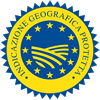Description
Speck Alto Adige PGI is a charcuterie product obtained from deboned, trimmed pig legs, with or without the topside, which are then salted, lightly smoked and cured.
Production Area
The production area of Speck Alto Adige PGI is within the entire territory of the autonomous Province of Bolzano.
Production Method
The selected pig legs are delivered fresh and must not weigh less than 10.5 kg; deboned and trimmed legs must weigh at least 5.2 kg and the surface must be homogenous without cracks or irregularities. From this point on in the processing, the legs are referred to as “baffe”. The rind of each leg is marked with the processing starting date so as to monitor the curing periods. Within four days of this date, the baffe are lightly salted and seasoned with fresh aromatic herbs. Cold smoking is carried out with non-resinous wood at a maximum temperature of 20°C. The baffe are then cured in special rooms with a temperature ranging from 10 to 16°C and a humidity level of 55-90%, according to local methods and traditions. The minimum length of the curing process depends on the final weight of the product, ranging from 20 weeks to 32 for heavier products.
Appearance and Flavour
Speck Alto Adige PGI is characterised by its “heart” or “shield” shape. The exterior is brown in colour and the slice is red with pinkish-white areas. It has a springy consistency; the lean parts are not sticky and the fat parts aren’t greasy. The flavour is typical, intense and sapid, but not salty, with smoky and spicy notes and hints of aromatic herbs.
History
Both tradition and historians date preserved meat production back to the period of the Longobard invasions. However, the first historical references to Speck date back to the beginning of the 3rd century, when in Alto Adige meat was already being successfully preserved with an unusual combination of smoking and open-air drying. Over the centuries, the art of dry salting and smoking was perfected in the “secret” recipes used by local producers. Being a South Tyrolean specialty that is also appreciated internationally, Speck Alto Adige PGI is honoured with an ad hoc festival in Val di Funes, the Speck Alto Adige Festival, which aims to introduce this typical high-quality product to the public.
Gastronomy
Whole Speck Alto Adige PGI should be kept in a cool environment – a cellar is ideal – with a temperature of around 5°C. The packaged product can be kept on the least cold shelf of the refrigerator for a few months, wrapped in a damp cloth and away from direct light. It is best to leave it at room temperature for a few hours before serving, in this way it regains its original fragrance and consistency. Speck can be cut in various ways: with or without the rind, by hand or thinly sliced with a slicer, diced, or in strips. Each of these methods determines a different sensation on the palate. Speck Alto Adige PGI is widely used in starters, first courses and main dishes: from traditional recipes, such as the typical canederli (bread dumplings) to more innovative combinations like melon and fig. It pairs perfectly with red wines, for example Alto Adige PDO Schiava, Alto Adige PDO Pinot Nero or Alto Adige PDO Lagrein.
Marketing
The product is marketed as Speck Alto Adige PGI. It is sold in single pieces, vacuum-packed or in modified atmosphere packaging, whole, in pieces or sliced.
Distinctive Features
The mixture of herbs is the only stage in which the producer is free to “personalise” their Speck Alto Adige PGI with “secret” recipes handed down the generations. The only restriction is that the percentage of salt in the final product cannot exceed 5 %.




































![[Milano] Presentazione My Selection 2025](https://www.qualivita.it/wp-content/uploads/2025/01/Appuntamenti-Mauro-MyCreations-25-210x118.jpg)

